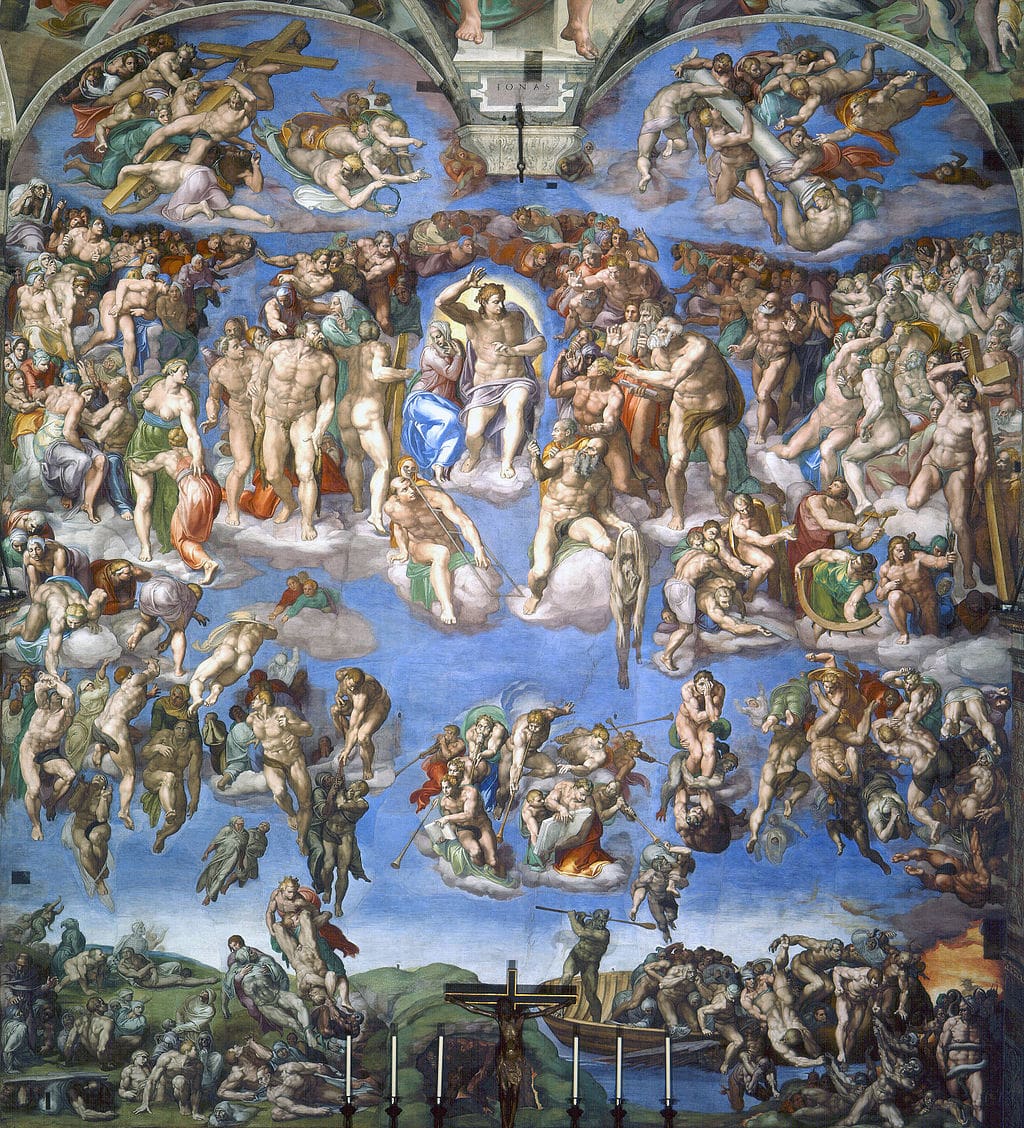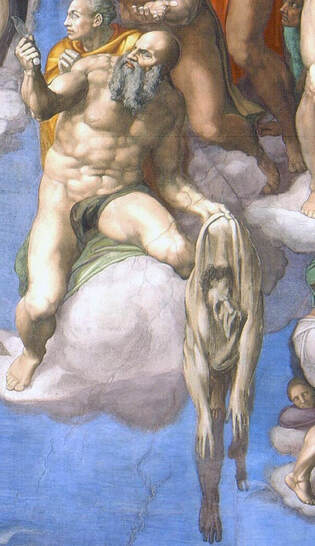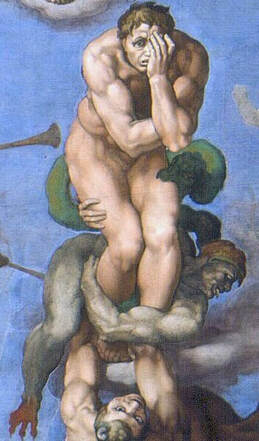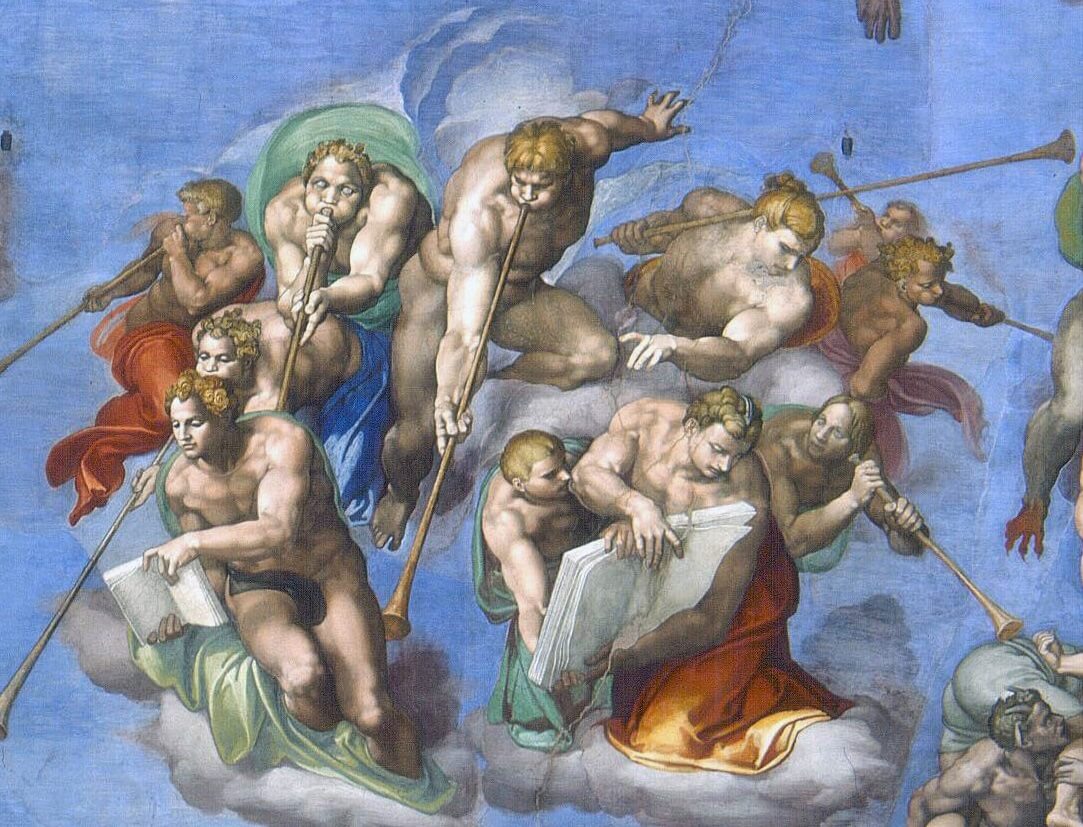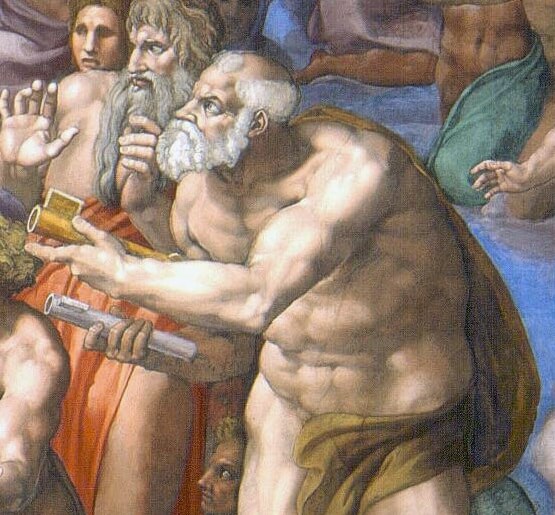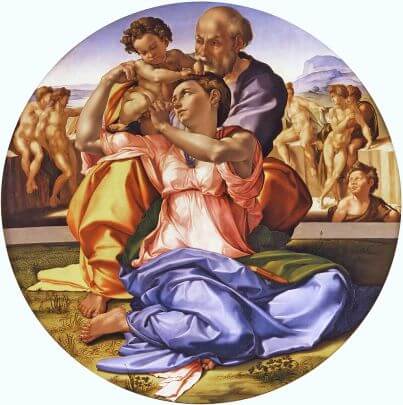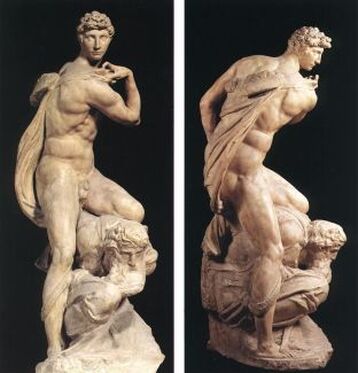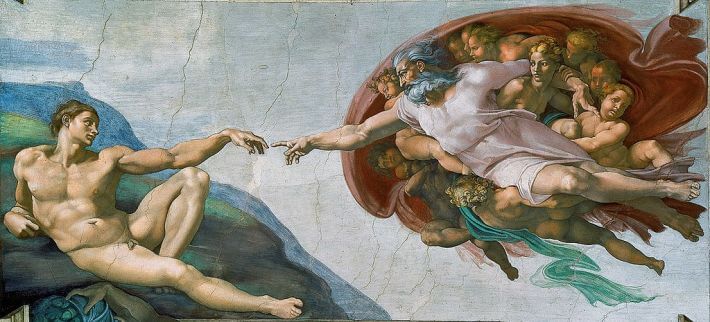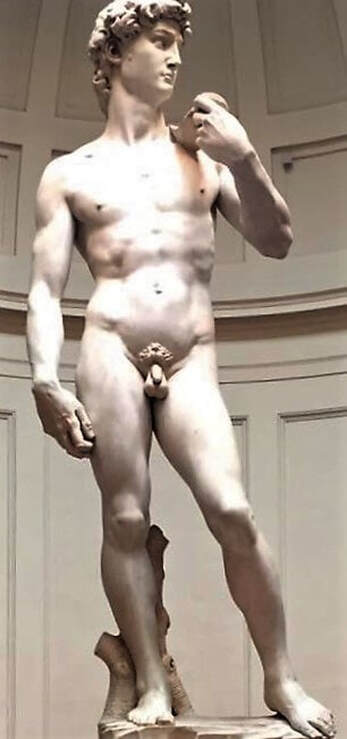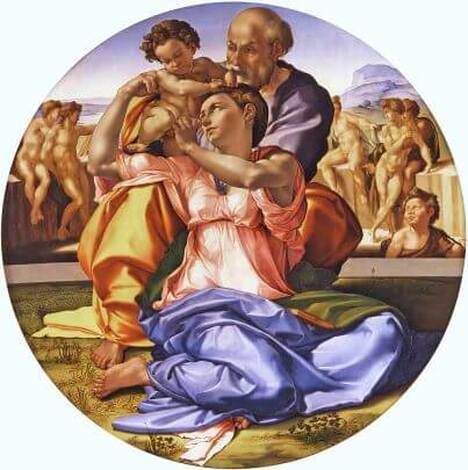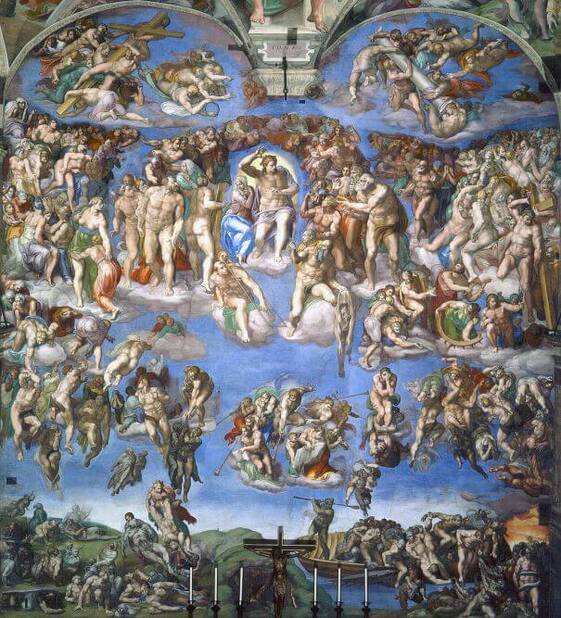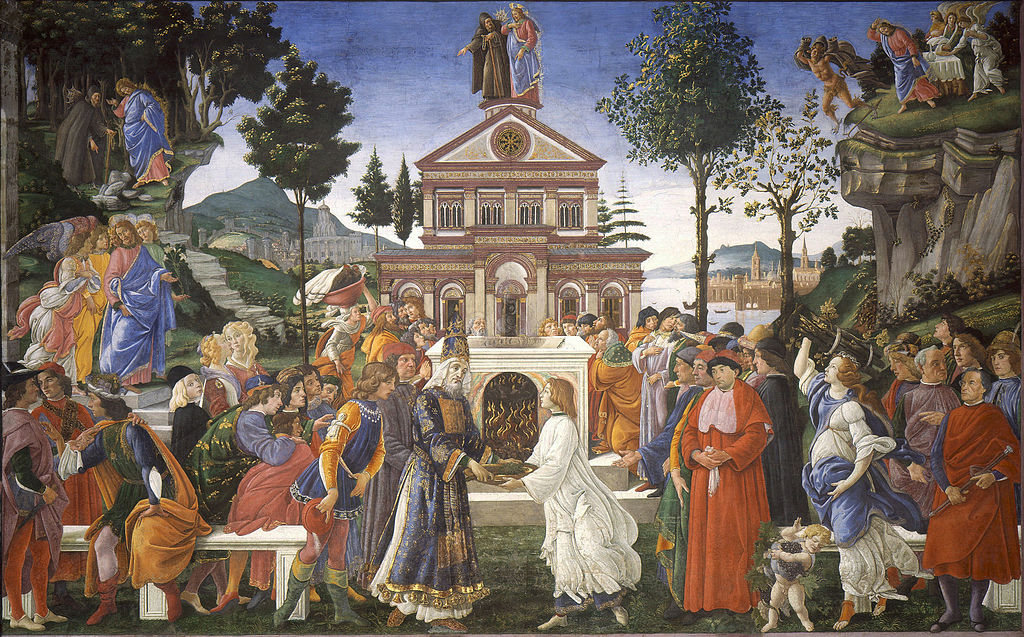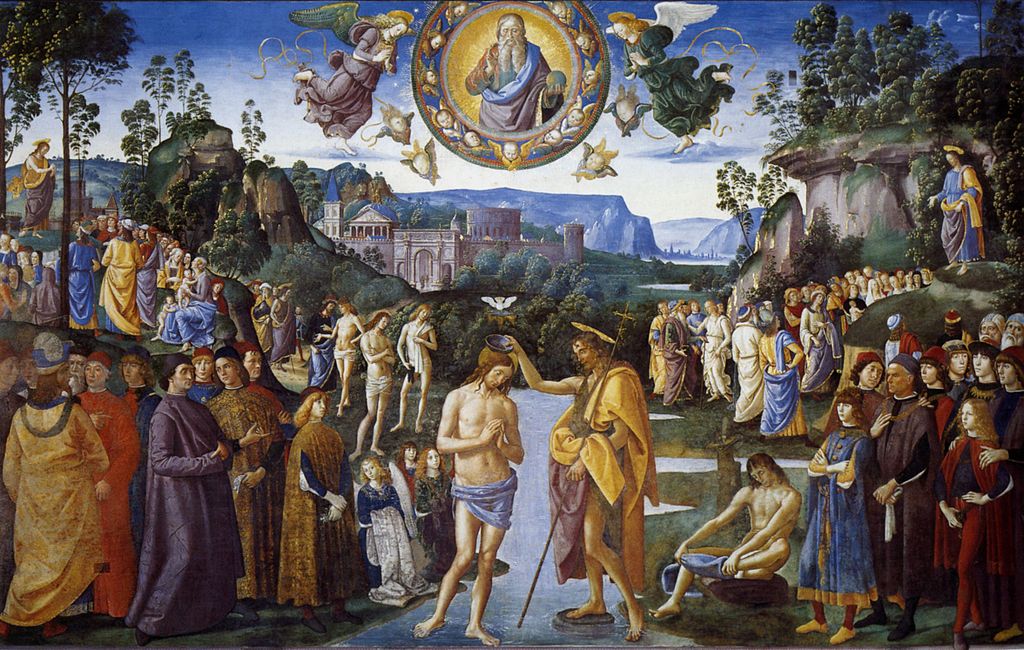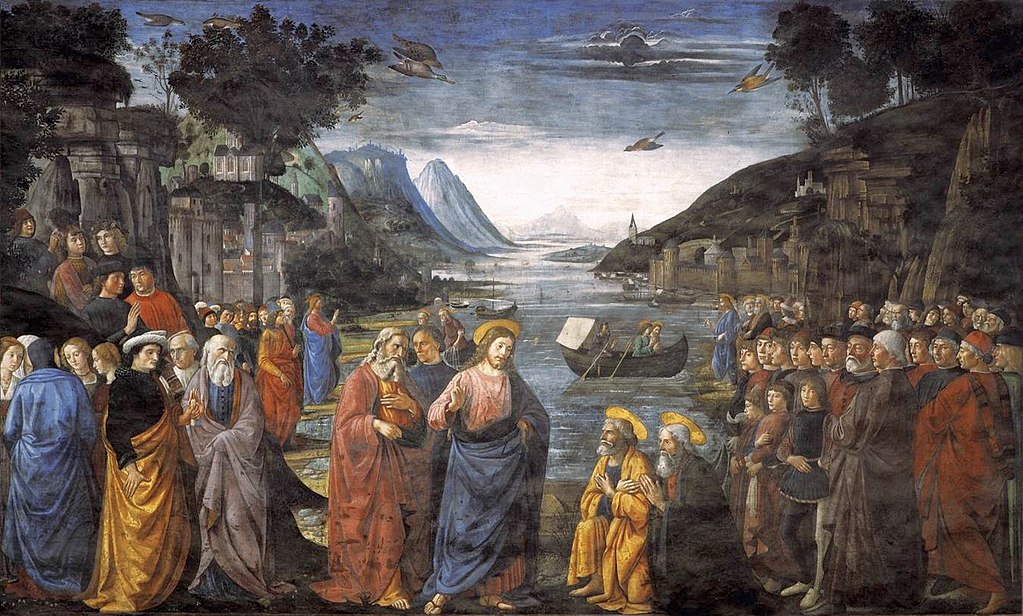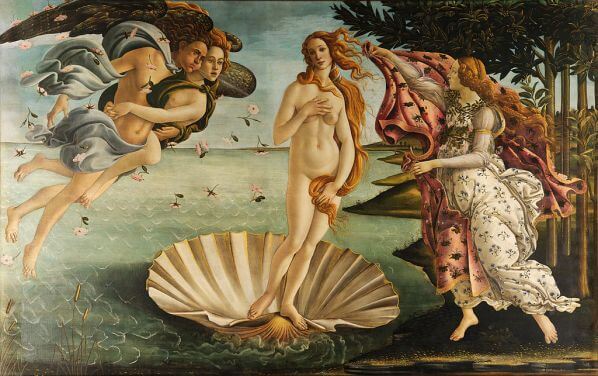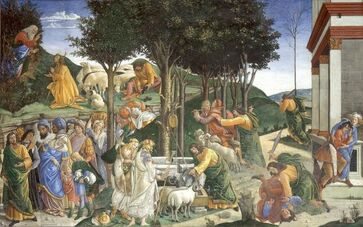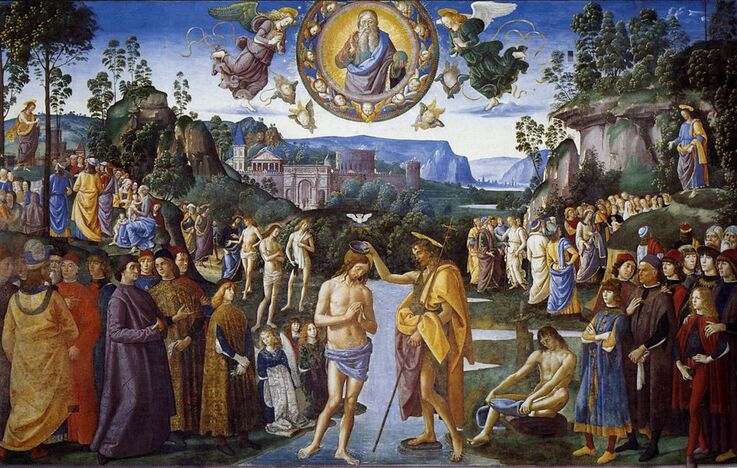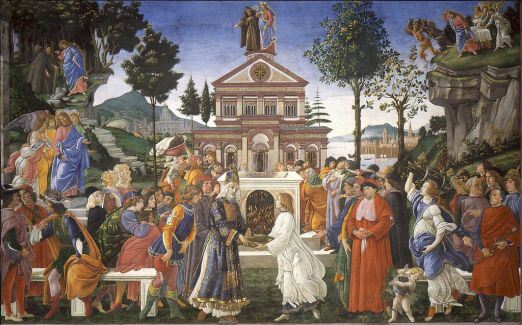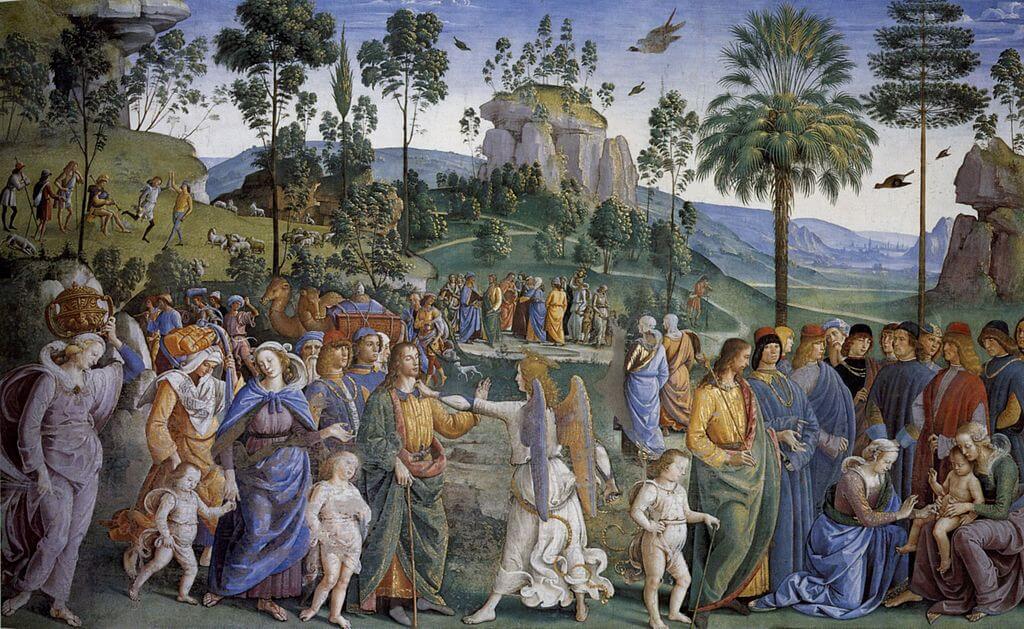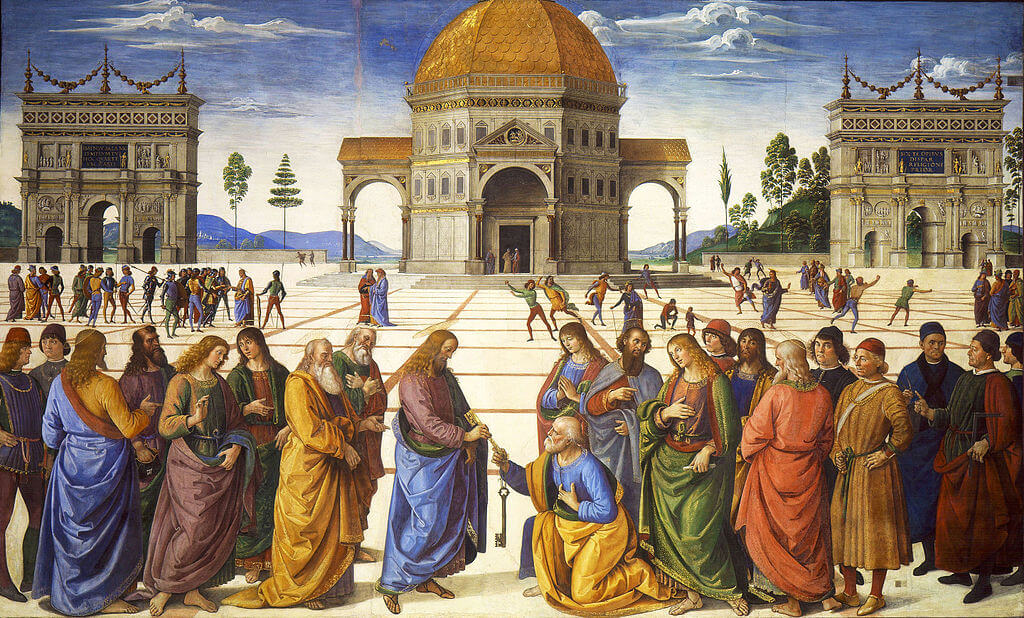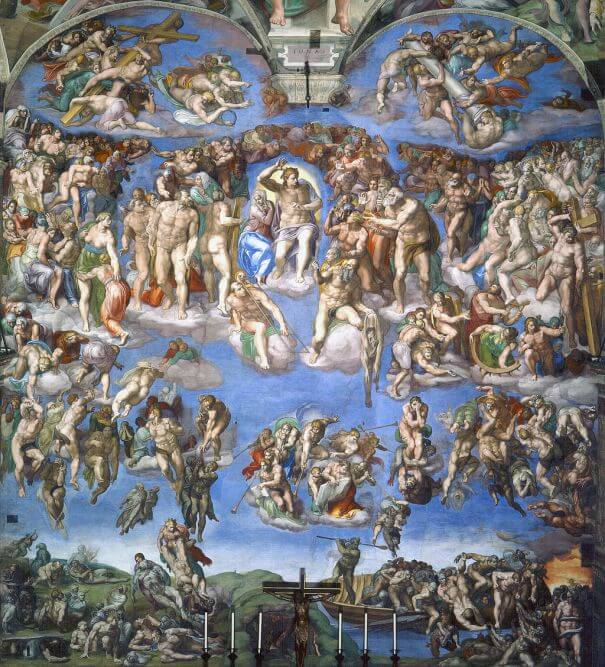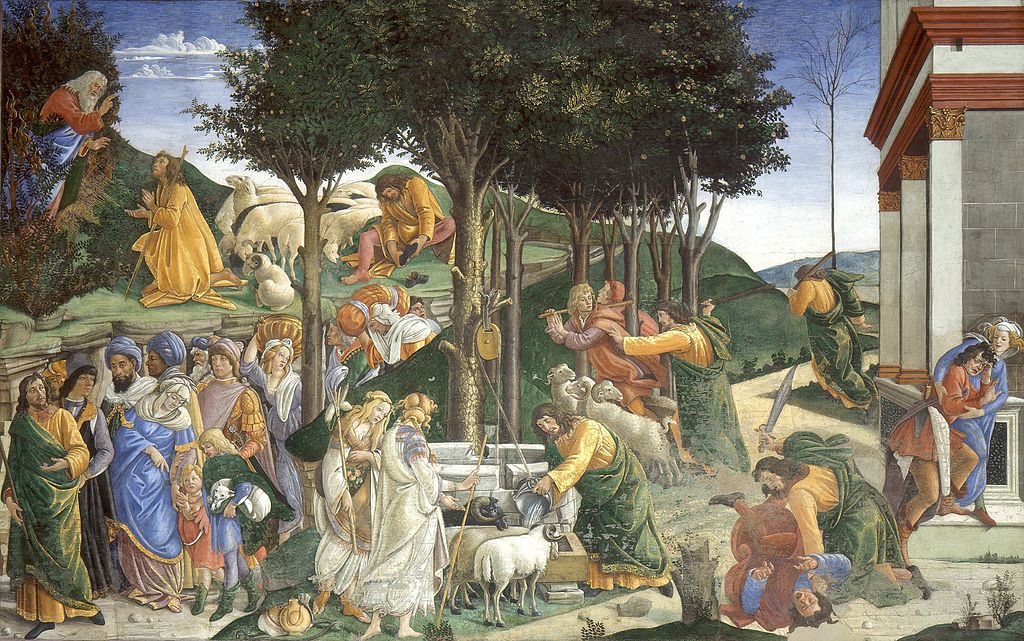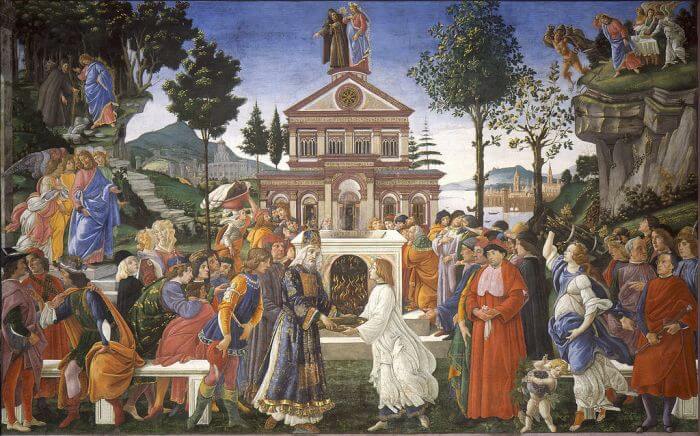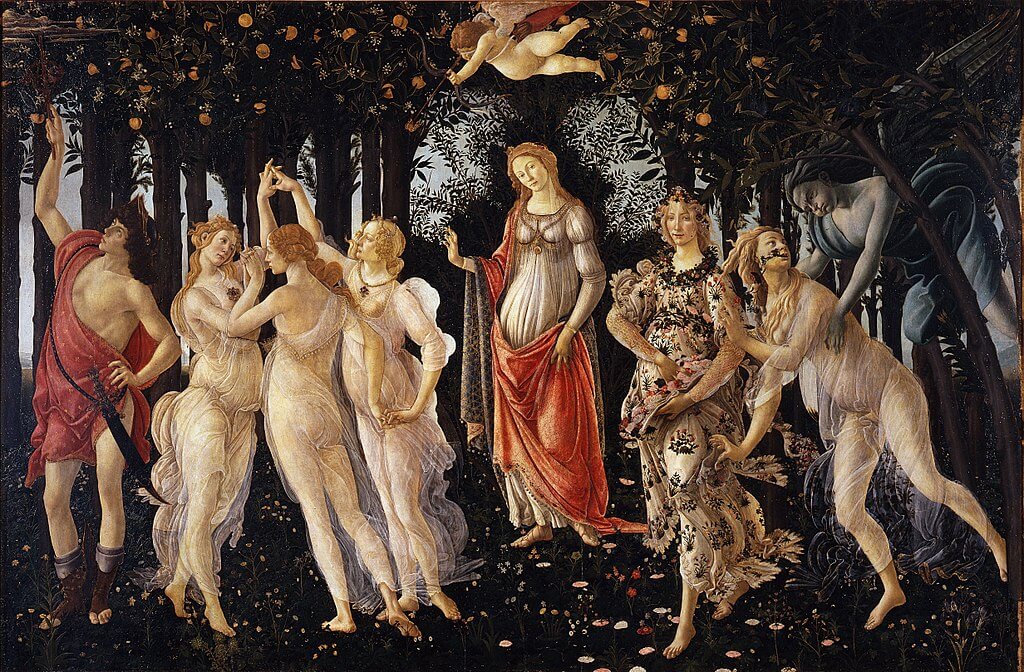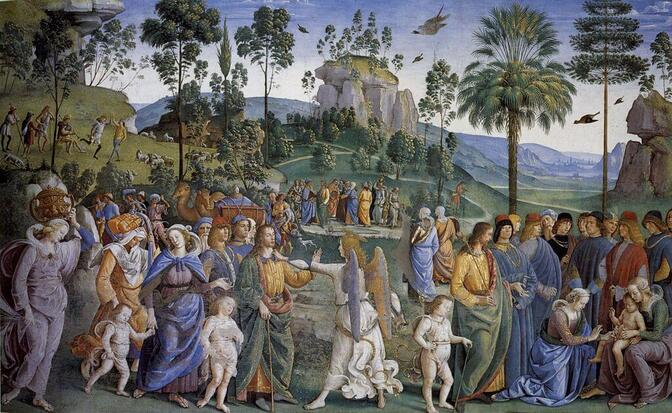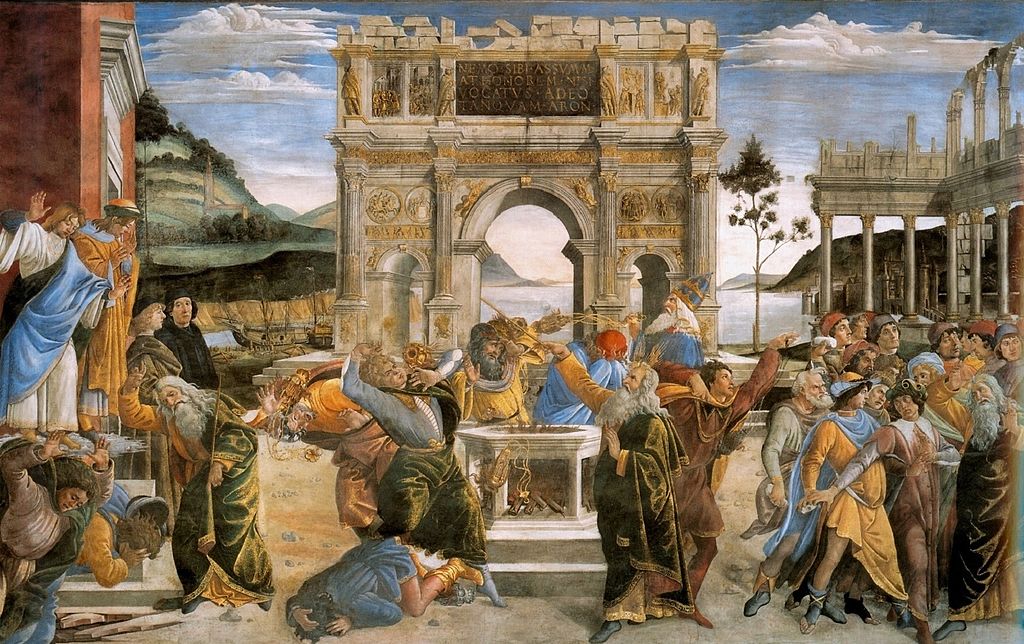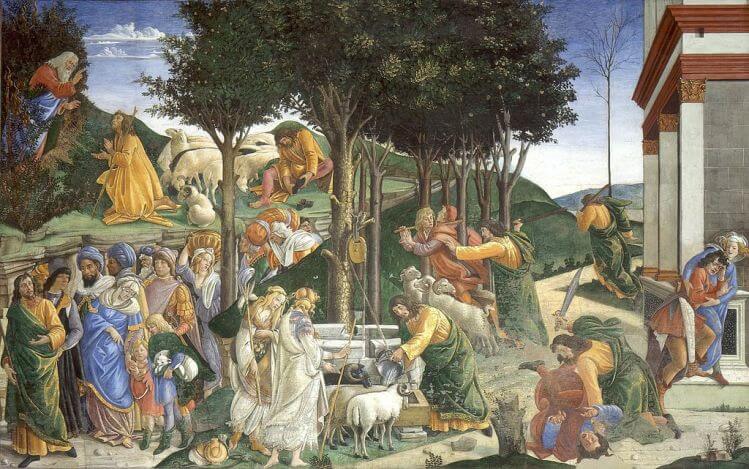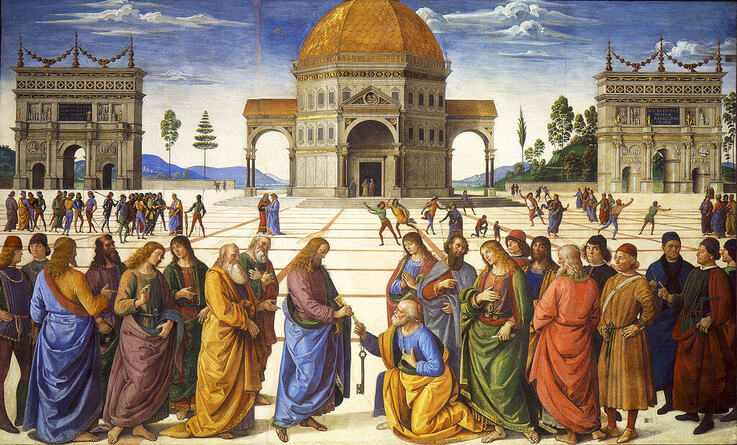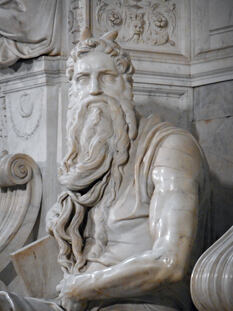|
Where? On the west wall of the Sistine Chapel in the Vatican Museums
When? 1536-1541 Commissioned by? Originally Pope Clement VII commissioned Michelangelo to paint a fresco about the resurrection, but after the death of Clement VII, Pope Paul III changed the topic of the fresco into the Last Judgment. What do you see? The painting can be divided into two scenes which are interconnected. On the top half is a scene with Jesus in the middle and on the bottom half is a scene where it is decided whether people go to Heaven or Hell. The scene surrounding Jesus: Jesus is the central figure in the top middle of the fresco. He stands on a cloud against the background of a golden aureole. He raises his right arm to condemn the people on the right of painting to Hell, and he puts his left hand forward to draw the blessed people on the left of the painting towards him. His figure has been modeled after the Apollo Belvedere which is also in the Vatican Museums. Jesus is surrounded in the top half of the painting by all sorts of saints and Biblical figures. While many of these figures cannot be precisely identified, some important ones stand out. To Jesus’ immediate left (from our perspective) is Mary with a red dress and a bright blue cloak. She looks to the blessed people on the left of the painting. She has a passive attitude as her role to intervene between the people who pray to her and God is no longer relevant.
The scene at the bottom: In the bottom left, people arise from their graves. In the scene above this one, some of these people are rising through the help of angels or clouds. These are the people that are saved.
In the bottom middle, above the cross of Jesus, there is a group of wingless angels who are blowing trumpets to awake the dead. They carry two books that contain the names of the people who are going to Heaven and Hell. The bigger book on the right contains the people that go to Hell. On the bottom right, there is a boat full of people who are going to Hell. Charon is standing on the left side of the boat and aggressively forces the people out of the boat. Minos is standing in the right bottom corner of the painting with a snake wrapped around him (and the snake bites his genitals). He is standing in front of the entrance to Hell. Charon and Minos are two figures described in Dante’s poem Inferno, and they are depicted exactly as Dante describes them.
Backstory: Michelangelo initially discussed the content of a large fresco in the Sistine Chapel with Pope Clemente VII in 1533. However, he only started to work on the actual fresco in 1536 under Pope Paul III. Before Michelangelo started his work on The Last Judgment (sometimes spelled The Last Judgement), the wall was covered by three frescos from Perugino.
Michelangelo decided that the wall should be rebuilt using high-quality brick stones and slope slightly inwards such that the wall could not collect dust. The goal of his fresco is to remember viewers of the upcoming day of the Last Judgment, where everyone, including the viewers, will be judged by God on whether they will go to Heaven or Hell. The painting caused quite some controversy when it was revealed. Controversial elements were the inclusion of mythological figures and the wingless angels in the fresco. Another important debate was about all the nudity in the fresco on the wall of a chapel. Originally the genitalia of many people in this fresco were visible. Around 1564, probably right after the death of Michelangelo, Danielle Da Volterra was ordered to cover some of these obscenities in this fresco.
Symbolism:This fresco contains lots of symbolism, and almost every attribute in the painting has a symbolic meaning. Below are a few examples.
The Last Judgment according to the Bible: The Last Judgment of all people who lived on Earth is an important aspect of the Christian religion. It is described as a moment in which all people will come to life again, and the good people will be rewarded by going to Heaven, and the evil people will go to Hell. There is a large number of references in the Bible to the Last Judgment (see here for a complete list). The most important and direct reference is in Revelations 20:11-15 in which the judgment day is described in a vision to John the Apostle. Another good source is Matthew 25: 31-46 in which Jesus explains the Last Judgment as the day when he will return to Earth with all his angels. Several main elements in this fresco can be linked to the Biblical stories. For example, the scene at the bottom left on the opening of the graves is based on Ezekiel 37:1-14. However, many aspects of this painting also differ from the Biblical description. Moreover, some elements are also inspired by non-Biblical sources, such as Dante’s Inferno. Who is Michelangelo? Michelangelo di Lodovico Buonarroti Simoni (1475-1564) was born in Caprese in the Republic of Florence. He lived most of his adult life in either Florence or Rome. From 1534 till his death he lived in Rome where he not only worked on this fresco in the Sistine Chapel, but he was also appointed lead architect of St. Peter’s Basilica. Michelangelo was an architect, painter, poet, and sculptor and he is remembered most for his paintings and sculptures. Only a few paintings of him have survived, including the Doni Tondo in the Uffizi Museum. However, he is better known for his amazing frescos such as the ceiling of the Sistine Chapel which includes the famous scene of The Creation of Adam. His sculptures are also considered to be among the best in the world. A couple of examples are his statue of David in the Galleria dell’Accademia and his Genius of Victory in the Palazzo Vecchio.
Fun fact: Michelangelo included about 400 figures in this fresco and has included these people in a large number of different positions. This required very extensive knowledge of the human body which is something Michelangelo possessed.
From a young age, Michelangelo participated in the dissection of the bodies of convicted criminals, something that the Pope allowed. The only condition was that the bodies of the criminals would be properly buried afterward. These dissections provided Michelangelo with very valuable knowledge of the human body, which was important for the realism of his sculptures and paintings. Michelangelo was not the only artists that dissected dead bodies. Multiple artists did this during that period, including Leonardo da Vinci, as the art moved away from unrealistic religious painting during the Middle Ages to more realistic and idealized human bodies during the Renaissance. Interested in a copy for yourself? Poster
2 Comments
The figures surrounding God: God is surrounded by twelve figures, which are identified as angels. However, the figure under the left arm of God stands out as she seems to be different. It is actually a woman and it is not clear who she is. Some have suggested that this is a female angel, others suggest that this is Eva, and even others suggest that she is the bride of God.
The left hand of God also touches one of the angels. This angel has been suggested to starkly resemble Baby Jesus in the Doni Tondo (in the Uffizi Museum), and may thus be God’s idea for the creation of Jesus. If this is true, then this painting also symbolizes the future coming of Jesus to reconcile the sins of Adam and his descendants.
Backstory: This painting is based on the biblical story in Genesis 1:26-27: “And God said, “Let Us make man in Our image, after Our likeness; and let them have dominion over the fish of the sea, and over the fowl of the air, and over the cattle, and over all the earth and over every creeping thing that creepeth upon the earth. So God created man in His own image, in the image of God created He him; male and female created He them.”
When reading this story in the Bible, many people have this image of Michelangelo in their minds. Michelangelo painted this fresco near the end of his work on the ceiling, which contains, among other things, nine scenes from the book of Genesis. However, the Creation of Adam has become the most memorable part of the series of frescos on the ceiling. Who is Michelangelo? Michelangelo di Lodovico Buonarroti Simoni (1475-1564) was born in Caprese in the Republic of Florence. He was a painter, sculptor, poet, and architect and he has had an enormous influence on the development of art. Some consider him the greatest artist ever, but he is certainly considered to be one of the four most important artists of the Renaissance, together with Donatello, Leonardo da Vinci, and Raphael. During his life, Michelangelo was considered to be the best artist on earth and earned the nickname Il Divino (the divine one). During his time in Rome with Pope Julius II, he painted the ceiling of the Sistine Chapel all by himself. It took him four years (1508-1512) to complete this ceiling, which is now considered to be one of the best frescos ever created. He also created The Last Judgment on the wall of the Sistine Chapel, which is also a very famous fresco.
Fun fact: In 1990, Frank Meshberger, a gynecologist, wrote a paper in the Journal of the American Medical Association claiming that the red background behind God and his entourage represents an anatomically correct image of the brain. This interpretation implies that this painting shows not only the gift of life by God but also the gift of intellect. He describes that Adam is already alive in this fresco and the real effort of God to touch Adam would be to give him a brain with intellect.
While many people are not completely convinced by this interpretation, it is not entirely unlikely. Michelangelo often dissected corpses to get a better understanding of human anatomy and he would thus have known how a human brain would look like. In addition, some of the sonnets that Michelangelo wrote also discuss the important role of the intellect of human beings. Another interpretation of the red background that gained some traction is that it is a depiction of a uterus and that this fresco symbolizes fertility. Interested in a copy for yourself? Poster of canvas (Amazon links)
Where? On the North wall of the Sistine Chapel in the Vatican Museums
When? 1481-1482 Commissioned by? Pope Sixtus IV What do you see? Five different scenes.
Backstory: Matthew 4: 1-11 describes the temptations of Christ. After Jesus was baptized, he went into the desert to think about how he would present himself to the world. He started by not eating for 40 days, and after this period the Devil visited him and tried to tempt him in three ways, as shown in this fresco. Surrounding frescos: The scenes on the North wall of the Sistine Chapel illustrate the life of Christ. These scenes are ordered chronologically. When you face the North wall, the first scene is depicted on the right (immediately next to The Last Judgment by Michelangelo). It illustrates the Baptism of Christ, as described in Matthew 3, and is painted by Perugino. This scene took place right before the temptations of Christ as painted by Botticelli. The third scene illustrates the Vocation of the Apostles by Ghirlandaio. This is what Jesus does right after he resisted the temptations by the Devil and this story is described in Matthew 4.
Symbolism:
Who is Botticelli? Alessandro di Mariano di Vanni Filipepi (1445-1510), better known as Sandro Botticelli, was born in Florence. He painted mainly religious subjects, but also some portraits and mythological subjects. Some of his best-known works include The Birth of Venus and La Primavera, which are both in the Uffizi Museum. In 1481, Pope Sixtus IV asked Botticelli to come to Rome to create some frescos for the Sistine Chapel. Over the next two years, Botticelli painted three frescos in the Sistine Chapel among which the current one, Punishments of the Sons of Corah, and Youth of Moses.
Fun fact: This fresco by Botticelli closely follows the Biblical story as described in the Gospel of Matthew. However, Botticelli made some changes to the story to please the commissioner. For example, the scene on the top left takes place in the desert according to the Bible. Botticelli, however, depicted the first temptation of Christ in front of a forest with oak trees, as the oak tree was the symbol of the Della Rovere family to which Pope Sixtus IV belonged.
Another clear deviation from the Biblical story is the depiction of the Temple. The large building in the middle of this painting is probably a copy of the old St Peter’s Basilica. It serves both as the backdrop to the scene in the middle foreground, where it is supposed to represent the Church, and the scene on the top middle, where it should represent the Temple. Other fun facts: Don’t forget to notice the young boy in the right foreground. He has a bunch of grapes in his hand and tries to keep it away from the small snake that is behind him. Also, to the left of the altar is a woman with a basket with two cocks or hens on top of her head, which are to be sacrificed. Interested in a copy for yourself? Poster or canvas.
Where? On the North wall of the Sistine Chapel in the Vatican Museums
When? 1482 Commissioned by? Pope Sixtus IV What do you see? This fresco illustrates four different scenes:
The baptism of Christ: The baptism of Christ is described in Matthew 3:13-17, Mark 1:9-11, and Luke 3:21-23. John the Baptist was baptizing people with water in the Jordan River. Jesus arrived there and asked John to baptize him as well. While John refused at first, Jesus convinced him that this was what God wanted. After Jesus was baptized, he came out of the water, and the Holy Spirit came down on him in the form of a dove. The dove said to Jesus: “You are my Son, the one I love. I am very pleased with you.” After that, the Holy Spirit sent Jesus into the desert for 40 days to prepare him for his public life. In John 1:29:34, John the Baptist also tells that he witnessed the Holy Spirit coming down on Jesus in the form of a dove. Backstory: This is the only work in the Sistine Chapel that is signed. Due to the large size of the fresco, and because Perugino was commissioned at least five other frescos in the Sistine Chapel (but only three survived), he used various assistants to help him . The best-known assistant was a young Pinturicchio, who continued to develop a successful career as a painter. Pinturicchio probably painted the landscape, and the scenes on the middle left and right. Surrounding frescos: The Baptism of Christ is the first out of seven frescos describing the life of Jesus. It is located on the right side of the North wall, directly next to The Last Judgment by Michelangelo. To the left is the second painting about the life of Jesus, which is Temptations of Christ by Botticelli. On the opposite wall are the seven frescos about the life of Moses. Some scenes from the life of Moses can be paired directly with scenes from the life of Jesus. In this case, the circumcision of the son of Moses in the right bottom of Moses Leaving to Egypt by Perugino is directly related to the baptism of Christ. Whereas in the Old Testament, circumcision of kids was the way to create a bond between God and the child, this was replaced by baptism in the New Testament.
Who is Perugino? Pietro Vannucci, better known as Pietro Perugino, was born around 1450 and died in 1523. Perugino was an apprentice of Del Verrocchio around the same time as painters like Leonardo da Vinci and Filippino Lippi.
Perugino was also the master of Raphael. He was one of the first Italian painters to use oil painting, a technique that was developed earlier that century by Jan van Eyck. In 1480, he was called to Rome by Pope Sixtus IV to paint several works in the Sistine Chapel. The most famous of his works is probably the Delivery of the Keys, which is also in the Sistine Chapel.
Fun fact: Perugino created six frescos in the Sistine Chapel. However, three of them have been removed to make place for The Last Judgment which Michelangelo painted between 1536 and 1541. It must not have been difficult for Michelangelo to remove the frescos of Perugino as Michelangelo was not a big fan of Perugino’s work.
The legend goes that Michelangelo told Perugino in his face that he was an amateur painter. Indeed, at the end of the 15th century, the career of Perugino went downhill, and he mainly repeated some of the compositions he had used earlier in his life. Interested in a Copy for Yourself? Poster or canvas.
Where? On the south wall of the Sistine Chapel in the Vatican Museums
When? 1481-1482 Commissioned by? Pope Sixtus IV What do you see? Seven scenes from the early life of Moses. In each scene, Moses is dressed in a yellow dress, and in five of them, he also wears a green cloak on top of it. The scenes illustrate the phases of Moses’ early life and how he became ready to become the leader of the Israelites.
The Biblical story: This fresco is based on the biblical stories as told in the book of Exodus. In Exodus 2:12, Moses kills an Egyptian man who was beating a Hebrew man. In Exodus 2:15, Moses decides to flee to Midian as the Pharaoh planned to kill him for his deed. In Exodus 2:16, Moses chases the men that were preventing the daughters of Reuel (also known as Jethro) to get water for their sheep and he helped them to give water to their sheep. In Exodus 3:5, God asks Moses to take off his sandals. In Exodus 3, Moses sees God in a burning bush, and God speaks to him and tells him that he should lead the Israelites out of Egypt. In Exodus 13:17, Moses leads the Israelites out of Egypt.
Symbolism: This painting contains many symbols, some of which are discussed below. In the scene where Moses flees from Egypt to Midian, you can see a tall tree without any leaves in front of him. This tree signifies the Tree of Knowledge to indicate that Moses will transform himself into a better person when he moves to Midian. In the scene where Moses helps the daughters of Reuel to provide water to their sheep, the woman on the left is Zipporah who Moses will marry later. She has a myrtle leave in her hair which symbolizes the conversion of a non-Jewish person to Christian faith. She also holds a spindle in her right hand (a device to spin wool into a thread), which is a reminder of the Virgin Mary. The water that Moses pours into the trough is a symbol of Baptism and the sheep symbolize the Church. In the scene on the top left, Moses has suddenly a golden rod in his hand which he received from God to lead the Israelites. Who is Botticelli? Alessandro di Mariano di Vanni Filipepi, better known as Sandro Botticelli, was born around 1445 in Florence where he also died in 1510. He spent most of his life in Florence, except between 1481 and 1482 when he painted three frescos in Rome, and an earlier period in which he spent some months in Pisa. He was an apprentice of Fra Filippo Lippi who taught him how to draw, paint, and how to create frescos. He completed various frescos during his life, but several of his Florentine frescos have been lost over time. He is best known for his framed paintings, including The Birth of Venus and La Primavera, which are both in the Uffizi Museum.
Fun fact: In the scene where Moses helps the daughters of Reuel, only two daughters are present, while the Bible mentions that there are seven daughters. The left of the two daughters is Zipporah, who Moses will marry later on. The fresco to the right of this one by Botticelli is made by Perugino and depicts Moses leaving from Midian to Egypt. In the scene on the right of this fresco, Moses is asked to circumcise his son Eliezer, who he got with his wife, Zipporah. So, while the frescos on this wall should be chronologically over time from right to left, occasionally the chronology is incorrect.
Where? On the south wall of the Sistine Chapel in the Vatican Museums
When? 1481-1482 Commissioned by? Pope Sixtus IV What do you see? The punishment of Corah (also spelled Korah), Dathan, and Abiram because they opposed the leadership of Moses. There are three different scenes:
Backstory: This painting is part of a series of frescos on the stories of Moses on the south wall of the Sistine Chapel. This series includes another fresco of Botticelli, which is Youth of Moses. The fresco on the Punishments of the Sons of Corah is based on three different stories from the Bible.
What is the Arch of Constantine? It is the largest triumphal arch in Rome. It was built to commemorate the victory in 312 AD of Roman Emperor Constantine I over another Roman Emperor, Maxentius, during a time in which there were multiple emperors in the Roman Empire. The arch is located next to the Colosseum.
The arch is 21 meters (23 yards) high and has three entrances as you can see in this painting. Roman Emperors walked under this arch when they entered the city after a victory. The Arch of Constantine is also depicted twice in the Delivery of the Keys by Perugino which is on the north wall of the Sistine Chapel in the Vatican Museums.
Symbolism: This fresco illustrates the claim of power of the Catholic Church and the papacy. It shows that only priests can perform holy duties and that God will punish people if they do not obey him. It also shows that God saves the people who obey Him. The Arch of Constantine is included to symbolize the victory of Christianity over paganism. The inscription from Hebrews 5:4 shows the holiness of the Pope as he was chosen by God.
Who is Botticelli? Sandro Botticelli was born in Florence in 1445 under the name Alessandro di Mariano di Vanni Filipepi. His father apprenticed Sandro to a goldsmith such that he could soon start making money for the family. As there was a close connection between goldsmiths and painters, Botticelli was able to become familiar with painting and discovered that this was his passion. He became an apprentice of Fra Filippo Lippi, one of the greatest painters of that time. Botticelli is best known for his famous paintings of The Birth of Venus and La Primavera, which are both in the Uffizi Museum.
|
Categories
All
|
- Home
- Blog
-
Museums
- Alte Pinakothek
- Art Institute of Chicago
- Baltimore Museum of Art
- Barber Institute of Fine Arts
- Bargello
- Barnes Foundation
- British Museum
- Church of Sant’Anastasia
- Cleveland Museum of Art
- Courtauld Institute of Art
- Detroit Institute of Arts
- Frans Hals Museum
- Galleria Borghese
- Gallerie dell'Accademia
- Getty Museum
- Guggenheim
- Hermitage Museum
- Kunsthistorisches Museum
- Kunstmuseum Basel
- Legion of Honor Museum
- Louvre
- Mauritshuis
- Metropolitan Museum of Art
- Musee d’Orsay
- Museum of Fine Arts in Boston
- Museum of Modern Art
- National Gallery in London
- National Gallery of Art
- National Museum in Poznań
- Norton Simon Museum
- Ny Carlsberg Glyptotek
- Palace of Versailles
- Palazzo Pitti
- Palazzo Vecchio
- Petit Palais
- Philadelphia Museum of Art
- Prado
- Pushkin Museum
- Ravenna Art Museum
- Rijksmuseum
- San Diego Museum of Art
- Santa Maria delle Grazie
- St. Peter's Basilica
- Städel Museum
- Statens Museum for Kunst
- Tate Britain
- Tate Modern
- Timken Museum of Art
- Uffizi
- Vatican Museums
- Wallace Collection
-
Artists
- Altdorfer
- Anguissola
- Berlin Painter
- Bosch
- Botticelli
- Boucher
- Bronzino
- Bruegel the Elder
- Brunelleschi
- Cabanel
- Caillebotte
- Canova
- Caravaggio
- Carpeaux
- Cezanne
- Cimabue
- David
- Degas
- Delacroix
- De Maria
- Donatello
- El Greco
- Fontana
- Fra Angelico
- Fragonard
- Gauguin
- Gentileschi
- Gericault
- Gonzalez-Torres
- Goya
- Hals
- Hogarth
- Hokusai
- Ingres
- Leonardo da Vinci
- Lippi, Filippo
- Longhi, Barbara
- Lorrain
- Makovsky
- Manet
- Massys
- Matisse
- Merian
- Michelangelo
- Mochi
- Modigliani
- Monet
- Panini
- Parmigianino
- Perugino
- Picasso
- Pisanello
- Raphael
- Rembrandt
- Renoir
- Reynolds
- Rivera
- Rodin
- Rubens
- Scultori
- Seurat
- Steen
- Tintoretto
- Titian
- Toulouse-Lautrec
- Turner
- Uccello
- Van der Weyden
- Van Dyck
- Van Eyck
- Van Gogh
- Van Hemessen
- Vasari
- Velazquez
- Vermeer
- Veronese
- Vigée Le Brun
-
Locations
- Books
- About Us

